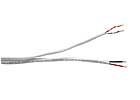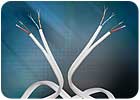
The unshielded twisted pair (UTP) cable in this assembly carries the video signal and the other pair carries the power.
As video surveillance systems evolve from analog to digital networked video, the wiring and cable used to carry their signals changes. Because analog cameras are operating in many existing installations, coaxial or mini-coaxial cables with RG designations are being used to carry the video signal, depending on the distance the signal has to travel.
But as digital networked video surveillance systems are installed, the wire used is Cat 5e for video data. Additionally, the fluctuating price of the copper used in coaxial and network cable in some cases is justifying a move to fiber optic cable, especially over long runs such as those among buildings or at airports.
In some applications, the destination determines the type of cable used for video surveillance. Coaxial cable is used frequently to connect surveillance cameras with digital video recorders (DVRs). If the signal from the DVR goes to a monitor, coaxial cable frequently is used, but if it goes to a network or a personal computer, twisted pair or other networking cable may be utilized.
Adding flexibility to video connections are hybrid cameras, which feature analog and network video connectors, and others that have fiber optic cable connections. For power, two-conductor wire usually is used, unless digital cameras are receiving power over Ethernet (poE), in which the power is provided on the same cable that sends the video data.
“The most popular cable for cameras today is an RG59 Siamese with an 18-2,†maintains Dave Spiller, president of Structured Cable Products, Fort Lauderdale, Fla. “That’s a 95 percent copper braid with a solid copper center and attached to the cable is two-conductor, 18-gauge stranded wire. We sell a million feet a month.â€

The middle two constructions of coaxial cable with two-conductor, 18-gauge stranded wire are called Siamese because they are a connected pair. The outside two are combined in a single jacket for ease of handling.
Sterling agrees that RG59 with 18-2 is popular. “About 90 percent of video systems are going in that way,†he estimates. “The guys installing the system are not going to change unless someone sits down and gives them a cost savings for changing, and that hasn’t happened yet.â€
Some cable assemblies include wire for control of pan-tilt-zoom (PTZ) cameras, which sometimes is unshielded twisted pair (UTP). Assemblies from some companies have no jacket around all the wires to cut away, but short distances among video components makes this feature less important, Sterling thinks.
Regarding picture quality, Sterling asserts, “It depends on who you talk to. Everything being equal, your signal is probably going to be better with coax.â€
Those who use baluns to send video over UTP wire say their signal goes farther with a better picture, but Sterling thinks high resolution usually is not utilized.
“If you’re trying to get a high-definition signal, you’re probably better off with coax, but a security system doesn’t use high-definition monitors,†he points out.

This unshielded twisted pair (UTP) Siamese and round composite cable construction allows the installer to pull one cable for video, control and power functionality for PTZ (pan-tilt-zoom) cameras.
DOES UTP SAVE MONEY?
UTP cable is being used in some installations because it requires less copper, the price of which has been unstable. As of press time, the most expensive that high-grade copper had been on the COMEX index was $407.55 per pound on May 23, compared with $216.80 on January 1.“The increase in copper prices has caught every dealer off guard,†concedes distributor Michael Young, owner of A-1 Security Supply, Hollywood, Fla. “We’ve had dealers walk away from jobs because the cost of the infrastructure is now more than they collected for the jobs. The budget was cut so tight that a 30 percent to 40 percent increase in cable cost caused a lot of people to pull back.â€
Young does not think jobs are being switched to Cat 5e because of copper prices. “A lot of the price-conscious video customers have already gone to the Cat 5 solution because they find that more cost-effective,†he thinks. “They suck up the cost difference. On video, the margins are a lot stronger for the dealer.â€
He points out that the average installation price for a video job can be from $4,000 to $6,000. “If cable is $30 more a roll for the video guy, he doesn’t really feel it as bad as the alarm guy or security guy working on a $200 to $300 job,†Young asserts. “Those are the guys feeling the pinch more than video.â€
Among the advantages of Cat 5 over coax cable is fitting more cable in conduit and going longer distances, Young maintains. UTP also is less susceptible to EMI and RFI and can carry video signals longer distances.
“A lot of these alarm guys are afraid to use Cat 5,†he asserts. “The little skinny cable scares them, so they stay away from these jobs due to their inexperience with that cable type.â€
Juan Gudino, marketing manager for low voltage cables and fiber-optics for Belden Americas, Richmond, Ind., thinks the cost differential with UTP is not that substantial. “There is a perceived difference in cost per foot of UTP versus coax, with UTP perceived to be cheaper,†Gudino points out. “However, UTP uses a base band transmission and needs other hardware called baluns to convert the impedance of the camera from 75 ohms to 100 ohms for the UTP transmission.â€
Honeywell’s Sterling points out that baluns are an additional expense, especially if they need to be powered. Then power also has to be run to them.
That may change when baluns are included in cameras, as they are presently in some models, says Nick LaBella, director of product marketing for CCTV for ADI, Melville, N.Y.
For more information about UTP video installation, see this month’s edition of “Kinks and Hints†on page 55.
Sidebar: Installation Tips
As with many cable installations in the security industry, rules such as selecting quality cable rated for the use intended (in plenums or risers, for example) by recognized standards organizations is recommended. Avoid sources of electromagnetic (EMI) and radio frequency (RFI) interference, such as MRI and CAT scan equipment in medical facilities, and keep to recommended clearances from electrical and other cables.“If you’re installing coax, obviously use proper termination techniques and sizes,†recommends Steve Sterling, marketing manager for Honeywell, Pleasant Prairie, Wis.
“There are all different connectors — some take a two-strip approach, some three-strip. Be sure you’re using the right tool to fit the right connector. Another thing is, if you’re running coax, run the proper coax for the distance you’re going.â€
Mini-coaxial cable can run 300 feet to 500 feet, depending on how powerful the amplification is, Sterling estimates. RG59 can carry a signal approximately 1,000 feet, RG6 for 1,500 feet and RG11 for 3,000 feet.
The longer the distance a signal can be carried, the thicker the wire. RG59 is from 20-gauge to 22-gauge; RG6 is 18-gauge; and RG11 is 14-gauge, Sterling states.
Distributor Michael Young, owner of A-1 Security Supply, Hollywood, Fla., recommends always using direct burial-rated cable in conduit underground. “A lot of guys think, ‘I’ve got it in pipe – it’s not going to get wet,’†Young relates, adding that it may.
He also advises using outdoor-rated cable for exterior applications because ultraviolet light, weather and water can degrade the cable’s jacket.
The other mistake Young sees is not determining what jobs require plenum-rated cable. “A lot of guys will put all regular cable in, only on the sign-off to find out it’s supposed to be plenum-rated,†he remembers. “That’s another one where you’ve lost immediately. It’s game over.â€
Juan Gudino, marketing manager for low voltage cables and fiber-optics for Belden Americas, Richmond, Ind., has additional tips. “Respect the manufacturers’ specifications on distance, cable types, shielding, etc.,†he advises. “Also, maintain bending radiuses, pulling tensions and termination procedures including the point of connection.â€

Sidebar: Fiber Optic Cable: 100 Percent Confidence
Fiber optic cable is being used to transmit data from video cameras that have fiber connectors. Such fiber cables are combined with 18-gauge, two-conductor wire for power.“It’s a little more sophisticated, and some installers are still a little afraid of fiber because of the connectors, but there is a trend starting to move to fiber, especially with the high price of copper,†notes Ed Constantine, senior product manager for wire and cable for distributor ADI, Melville, N.Y.
The bending radius of fiber optic cable is better than copper, Constantine maintains, but the difficulty for installers with fiber besides unfamiliarity is attaching connectors.
“People who do not know how to handle it — when they put connectors on, they potentially could break the glass or put a kink in it,†Constantine observes. “Fiber never really caught on in the camera world because coax did such a great job, and nobody saw the need.
“Fiber used to be very expensive, but bulk fiber cable itself has come down in cost over the last few years. The connectors and modulators are also more competitive now,†Constantine emphasizes.
He estimates attaching an RJ45 connector to Cat 5e cable can take an experienced installer less than 3 minutes, but attaching a fiber-optic connector may take a bit longer.
“You’re talking about cutting the glass, scribing and cleaning the end of the glass, cutting off the rough edges, then crimping the connector and putting it on,†Constantine relates. “The end of the connector has to be polished. There are a couple different steps there.â€
Cat 5e cable transmits at gigabyte speed, so fiber has no speed advantage, Constantine insists. But one inherent advantage fiber has over any copper cable is the ability to be secure. Fiber cannot be tapped, allowing sensitive data to be sent with 100 percent confidence, he emphasizes.
It also has a distance advantage over Cat 5e and can be used when it is already installed in a facility. “You can run fiber forever,†Constantine insists. “Where you see fiber come into play is extreme distances of interconnecting buildings.â€